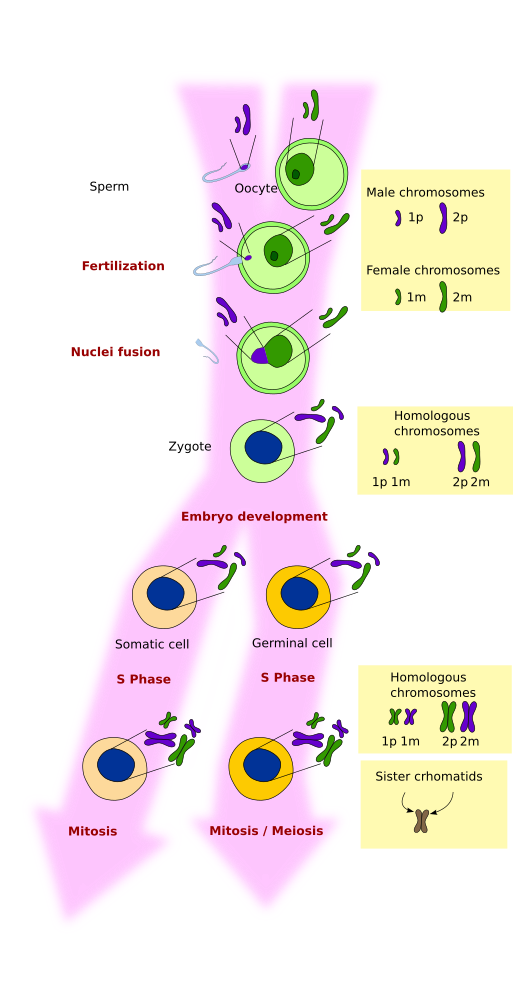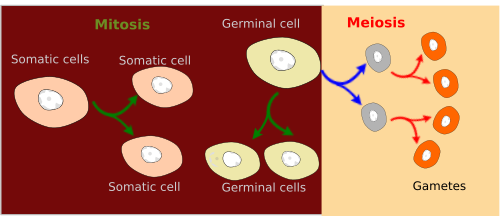Cells of multicellular organisms can be classified into two broad categories: somatic and germinal cells. Somatic cells account for nearly all the body and proliferate by mitosis, giving two new somatic cells after every division. Germinal cells are much less abundant. They are found in gonads, where they can produce either more germinal cells by mitosis or gametes by meiosis. Gametogenesis is the process by which germinal cells divide by meiosis to give haploid cells that become gametes. Two things happen during meiosis: chromosome recombination and the reduction of the number of chromosomes by half.
Before going further, let's make some concepts clear. Every cell contains two sets of chromosomes, one coming from the mother and the other from the father (Figure 1). For instance, if the cells of a species contain 4 chromosomes (there are 46 in humans), the female provides two chromosomes (1m and 2m) and the male the other two (1p and 2p). 1m and 1p chromosomes have the same genes, and they are sorted in the same order along the chromosome. However, these genes do not show identical nucleotide sequences. Although they express the same proteins, there are some variations when comparing the nucleotide sequences. Genes located in the same position of two homologue chromosomes coding for the same messenger RNA with slightly different sequences are known as alleles. So, 1p and 1m chromosomes have alleles, two per gene, one coming from the male and the other from the female. The same happens to the 2m and 2p chromosomes. Thus, 1p and 1m are identical but homologous chromosomes. In this species, there are two couples of homologous chromosomes, whereas in humans, there are 23 pairs of homologous chromosomes. During gametogenesis, meiosis reduces the number of chromosomes by half, and there is always one chromosome of every pair of homologous chromosomes in each gamete. Germinal and somatic cells, which always have the two members of each pair of homologous chromosomes, are known as diploid, whereas gametes, having only one member of each pair, are known as haploid.

Meiosis is a cellular process that reduces the number of chromosomes by half. Every gamete keeps one chromosome of every pair of homologous chromosomes that were present in the germinal cell (Figure 2). During meiosis, there is also a molecular mechanism known as recombination (Figure 2). As we saw above, in somatic and germinal cells, the genetic information coming from the male and female is in separated chromosomes. Both male and female provide one chromosome to every pair of homologous chromosomes. During recombination, there is exchange of segments between homologous chromosomes. It means that some genes of the chromosome provided by the mother are now in the chromosome provided by the father, and the other way around. Thus, there are chromosomes with combination of genes (alleles) that did not exist previously. After fertilization, these chromosomes with genes from both progenitors may influence the features of the new organism.

Do not confuse meiosis and mitosis (Figures 2 and 3). During mitosis, the DNA is duplicated and then divided between the two daughter cells, so that the two new cells have the same information as the progenitor cell. During meiosis, although the DNA is also duplicated, the germinal cell divides twice (meiosis I and meiosis II), giving four haploid cells. In males, these four cells become sperm, and in females, only one of these cells develops into an oocyte.

Meiosis has several phases that are similar in both males and females of all species with sexual reproduction. Briefly, the duplication of DNA occurs during S phase, and then follows meiotic prophase (leptotene, zygotene, pachitene, diplotene, diakinesis)(Figure 4), meiosis I (first division: metaphase I, anaphase I, interphase without S phase), and meiosis II (second division: prophase II, metaphase II, anaphase II). Chromosome recombination takes place during prophase I, and there is a reduction in the number of chromosomes during divisions (meiosis I and II).

Regarding chromosomes, the meiotic process is similar in both males and females of almost all species. Chromosome recombination and reduction of the number of chromosomes happen in all eukaryotic species with sexual reproduction. However, remarkable differences are observed between spermatogenesis (male gamete differentiation) and oogenesis (female gamete differentiation). Gametogenesis is also quite different between species. These differences give clues about how fertilization and posterior embryonic development of a particular species are going to be.
 M Phase
M Phase